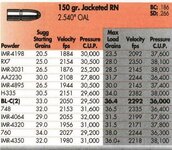Can you use load data from old manuals? Heres the thing i run into all the time. Load data for the 30-30 for example.
lyman 49 and 48 data is the same but lyman 44th is way different and if you follow it, you will blow yourself up according to the 48th and 49th.
the 48th says IMR-3031 max charge is 28.5 for 2145fps @ 2.540 COAL tested with 24" barrel. The 44th has the max charge at 33.5 for 2347 @ 2.550 COAL with a 21" barrel.
And look at the IMR-4895 loads. 48th says 30.0 for max. 44th says 36 is max. and Factory Duplication Load is 35.
Reloading with OCD is not conducive to my sanity.
My Hornady manual says max charge is 31.4 at 2.550
Thats my rant for the day


lyman 49 and 48 data is the same but lyman 44th is way different and if you follow it, you will blow yourself up according to the 48th and 49th.
the 48th says IMR-3031 max charge is 28.5 for 2145fps @ 2.540 COAL tested with 24" barrel. The 44th has the max charge at 33.5 for 2347 @ 2.550 COAL with a 21" barrel.
And look at the IMR-4895 loads. 48th says 30.0 for max. 44th says 36 is max. and Factory Duplication Load is 35.
Reloading with OCD is not conducive to my sanity.
My Hornady manual says max charge is 31.4 at 2.550
Thats my rant for the day














